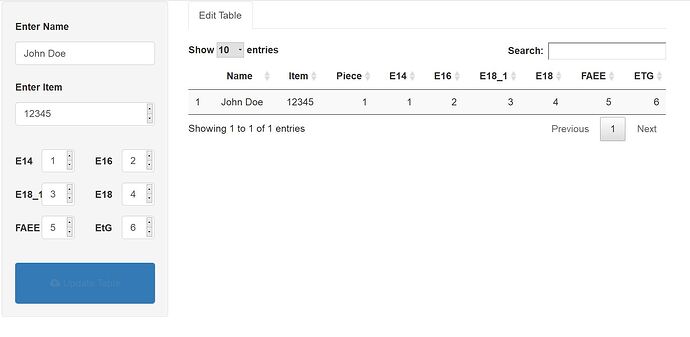library(shiny)
ui <- fluidPage(
tabPanel("New Cases", icon=icon("edit"),
sidebarLayout(
sidebarPanel(width=3, #sidebarPanel "New Cases"
conditionalPanel(
'input.dataset02 === "Edit Table"',
textInput('NewID', HTML('<h5><b>Enter Name</b></h5>')), #Enter Factor?
numericInput('NewVal1', HTML('<h5><b>Enter Item</b></h5>'), NULL),
br(),
fluidRow(
column(2, HTML('<h5><b>E14</b></h5>')),
column(4, numericInput("NewVal3", label = NULL, value = NULL)),
column(2, HTML('<h5><b>E16</b></h5>')),
column(4, numericInput("NewVal4", label = NULL, value = NULL))
),
fluidRow(
column(2, HTML('<h5><b>E18_1</b></h5>')),
column(4, numericInput("NewVal5", label = NULL, value = NULL)),
column(2, HTML('<h5><b>E18</b></h5>')),
column(4, numericInput("NewVal6", label = NULL, value = NULL))
),
fluidRow(
column(2, HTML('<h5><b>FAEE</b></h5>')),
column(4, numericInput("NewVal7", label = NULL, value = NULL)),
column(2, HTML('<h5><b>EtG</b></h5>')),
column(4, numericInput("NewVal8", label = NULL, value = NULL))
),
br(),
actionButton("goButton", "Update Table",icon("cloud-upload"),
style="width: 100%; height: 60px; color: steelblue; background-color: #337ab7; border-color: #2e6da4"),
br()
)),
mainPanel(
tabsetPanel(
id = 'dataset02',
tabPanel("Edit Table",
br(),
dataTableOutput("table3"))
))
)))
server <- function(input, output) {
mydata3 = data.frame(Name=letters[NULL], Item=sample(NULL),Piece=sample(NULL), E14=sample(NULL), E16=sample(NULL),
E18_1=sample(NULL), E18=sample(NULL), FAEE=sample(NULL), ETG=sample(NULL))
output$table3 <- renderDataTable( df3())
df3 <- eventReactive(input$goButton, {
if(input$NewID!=" " && !is.null(input$NewVal1)
&& !is.null(input$NewVal3) && !is.null(input$NewVal4) && !is.null(input$NewVal5)
&& !is.null(input$NewVal6) && !is.null(input$NewVal7) && !is.null(input$NewVal8)
&& input$goButton>0)
{
newrow = data.frame(
Name = input$NewID,
Item = input$NewVal1,
Piece = 1,
E14 = input$NewVal3,
E16 = input$NewVal4,
E18_1 = input$NewVal5,
E18 = input$NewVal6,
FAEE = input$NewVal7,
ETG = input$NewVal8)
mydata3 <<- rbind(mydata3, newrow)
}
mydata3
}, ignoreNULL = FALSE)
}
shinyApp(ui = ui, server = server)
I am working on a Shiny app that allows the user to upload their own data and analyze them. At a certain point, I'd like to allow the user to introduce new data as numeric input and to build a new table including them.
I'd like my app to do it dynamically, i.e. creating a box in the sidebar panel containing new numeric input accordingly and with the name of the variables of my uploaded dataset.
I can do it by indicating a priori specific variables, but I'd like to make it dynamic.
I'd be really glad if somebody could attend to this matter. Here's included a simple example of my code and a screenshot showing how it looks like (but with a priori specified variables).
Screenshot of the app (in the "desired" format) is the following:
